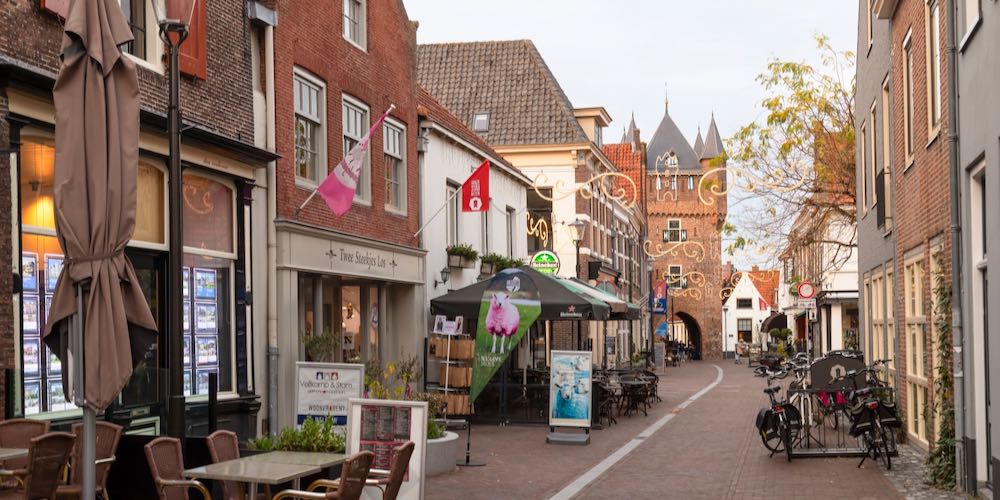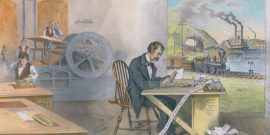The Dutch Roots of Capitalism
When the Dutch celebrate their King’s birthday on 27 April, a national holiday, a lot of them become merchants for one day. At so-called vrijmarkten (literally: “free markets”) children and grown-ups sell toys, books, games, cookies, and other “merchandise,” or play music for money in parks, streets, and squares, haggling over prices and often using the proceeds to become buyers themselves at the same market. Municipalities abandon traffic for the occasion and keep professional merchants at bay. For Maarten Prak and Jan Luiten Van Zanden, two recently retired professors in economic history from Utrecht University, this custom is evidence of how deeply the spirit of capitalism is rooted in Dutch culture.
In Pioneers of Capitalism, the authors aim to explain the origins of the Dutch market economy. They consider why it was the Netherlands that became a pioneer in the history of capitalism, and attempt to distinguish what effect the capitalist market economy had on the nature of Dutch society. The book is not just historical; they contextualize their findings in modern academic debates about the nature of capitalism, the relation between institutions and modern economic systems, and modern themes such as social inequality. It is not surprising to see references to the ideas of Nobel Prize-winning economic historian Douglas North, while the ideas of Karl Marx are used as the other theoretical pole.
The book focuses on the period between the year 1000 and 1800. That is not coincidental, because one of the main arguments of Prak and Luiten van Zanden is that Dutch capitalism has much older roots than scholars often assume. The Dutch Golden Age in the 17th century should not be seen as the beginnings of capitalism, but as the amazing result of developments that originated centuries before. Working on ideas developed by Simon Kuznets and Angus Madison, they determine that Holland has had consistent GDP growth from 1350 onwards. It did not stop after the relative decline of the Dutch Republic from 1670 onwards, which Adam Smith referred to as a “stationary state” of a highly developed economy. In a glimpse of the time beyond their study period, the authors disclose that the underlying processes of productivity growth continued. Until 1820 this was “Smithian growth,” hence the result of growing market production, specialization, and commercially induced technological change. After 1820, it was based on the exploitation of a rapidly expanding knowledge base, which resulted in the kind of technological change that still dominates the world economy today.
In the Middle Ages the Frisians would use their freedom to dominate the North Sea trade between England, Scandinavia, northern Germany, and northern France.
The Netherlands started as a marginal and undeveloped “marshy delta” in the North-West corner of Europe. Yet foundations for capitalism were already present in these feudal times. A visiting monk described how around the year 1015, merchants of the then-principal commercial town of Tiel organized themselves and had certain independent rights bestowed on them by the German Emperor. (The Netherlands were part of the Holy Roman Empire at the time.) In fact, they were a merchant guild, and other guilds would follow. They enjoyed rights to self-rule, were permitted to pool capital and resources, and maintained their own system of justice. Besides the old Roman cities of Maastricht, Nijmegen, and Utrecht, urbanization took place in the river towns in the east of the country along the river IJssel, such as Deventer, Zutphen, and Zwolle, which would join the Hanseatic League after 1356. Dordrecht, Amsterdam, and other cities in the Western part of the country developed (much) later.
The location on the geographical fringes of Europe meant that central power by the German empire or the French King was hard to establish. This led to the growth of relatively strong local towns and regions, which would evolve into the Dutch provinces. Feudalism existed in the South (Zealand, the River area), but was not as strong as elsewhere in Europe. The Northern part enjoyed “Frisian freedom,” which meant a de facto independent rule, without a central authority. In the Middle Ages, the Frisians would use this freedom to dominate the North Sea trade between England, Scandinavia, northern Germany, and northern France. This trade was fostered by the physical circumstances: the population held cattle, rather than field crops, and excelled in textile production which was traded for grain, to make bread. The use of gold and silver coins was also widespread among the Frisians (as opposed to the rest of the country).
In the West, an important feature was the draining of wasteland, in first instance for harvesting peat for heating, and later for farmland. Local rulers, such as the Count of Holland and the bishop of Utrecht, gave rights to developers, who then contracted groups of men to carry out the draining work. These contracts included provisions of the future taxes to be paid to the rulers. Local communities emerged after the reclamation works, which set up local drainage or dike boards (heemraden, which exist to this day) that found a balance between the duties to be paid and having a say in the affairs through the election of representatives. Between 1000-1350 the Netherlands already saw a relatively strong civil society (guilds, draining boards, autonomous villages, and cities) including institutions such as regular meetings and elections.
People trusted the market, and dared to put their fate in its hands. And the market delivered: it is estimated that after 1350, around 40-60% of the population depended partly or entirely on wage labor for a living.
Feudalism, often seen as static and hierarchical, actually played an important role in the capitalist development of the Netherlands, which would be characterized by a mix of feudal and free structures. The reciprocity between lord and vassal fostered cooperation, was flexible, and could easily adapt to changing circumstances, allowing room for merchants’ guilds and cities. The element of trust came into play through an oath-based system of allegiance. Feudal times saw an explosion of agricultural produce and the harvesting of peat bogs for heating, which allowed for rapid population growth. Naturally, the Church also played a major role, insofar as it ensured some European unity in norms and values. It was also an economic factor in itself, for example through church building. Comparing international research on church construction, it turns out that the Netherlands lagged behind until the fourteenth century, but then quickly caught up and surpassed other European countries.
The Late Medieval period (1350-1566) saw the real birth of Dutch capitalism. In these two centuries, urbanization accelerated, waterways and sea navigation improved, and public administration professionalized, while core capitalist institutions, such as division of labor and specialization, were able to flourish. Most notably, capital became important for structural economic growth, as seen for example in the widespread trade and commercial lease of land. International (grain) trade became of major importance, as the Dutch controlled the sea routes from the Baltic to the south of Europe. The market became the central mechanism for economic allocations, regulated by (local) rules. People trusted the market, and dared to put their fate in its hands. And the market delivered: it is estimated that after 1350, around 40-60% of the population depended partly or entirely on wage labor for a living. GDP growth per capita was 40% in the second half of the fourteenth century. Around 1500 new financial instruments were invented, while interest rates had fallen from around 12% to 5-6%. An important difference with other European countries, such as Italy, was that the cities did not control the surrounding countryside. These villages were left free to take care of themselves.
A striking element in the development of Dutch capitalism was the comparatively high literacy of the population, not least due to Geert Grote’s church renewal movement, Modern Devotion, which stimulated individual reading and writing. From the fifteenth century onwards, book and manuscript production grew spectacularly, almost doubling the European average, with the Hanseatic town of Deventer at its center. Dutch women had a relatively strong societal position; for example, marriage was based on consensus between husband and wife. The Netherlands were also a relatively safe place, where the elites were relatively content, relying on state and related institutions to settle disputes. Property rights were well organized and protected.
In 1581 the Northern Dutch provinces declared themselves independent from the Habsburg empire, in the Act of Abjuration. This was not a capitalist revolution, in the sense that it was the start of a capitalist regime. It was about freedom: of religion, and the will to get rid of strict foreign rule. In fact, the war against the Spanish was made possible by capitalism: the revenues from trade (especially grain) were so large that a prolonged war could be financed by such a small country. This was also helped by a wave of highly skilled immigrants fleeing from the Southern Netherlands (Ghent, Antwerp). It is estimated this amounted to population growth of about 10%. The Northern cities were also fairly tolerant of religious minorities such as Jews. The economic boom of the early “Golden Age” (as the Dutch like to call it) was also stimulated by two highly successful governmental inventions in Amsterdam: a public exchange bank, called Wisselbank, (with the municipality as guarantor) and a public credit bank (Bank van Lening), both frontrunners of today’s central banks. They combatted instability arising from speculation and the manipulation of exchange rates, and sought control and stabilization of the monetary and financial systems.
In their foreword, Prak and Van Zanden disclose that Joel Mokyr, the series editor of the Princeton Economic History of the Western World, demanded the inclusion of an analysis of the Dutch colonial empire. The Dutch East India Company (VOC), from 1602 onwards, can be seen as one of the first modern companies in the world: a limited liability company, with traded shares on the stock exchange, speculation on these shares, and a division between ownership and management, which led to all kinds of conflicts. The VOC needed and attracted huge amounts of money, used for building trading posts, harbors, fortresses, infrastructure, and so forth. This resulted in a stable, well-funded global commercial enterprise that controlled large parts of the trade between Asia and Europe and between Asian ports, for more than 200 years.
The main traded commodities changed throughout these years, from spices to Indian textiles, followed by coffee and sugar from Java, and tea from China. Needless to say, modern capitalism was not the only basis for success; the VOC used slavery in Asia, South Africa, the Caribbean, and South America, and abused (sometimes mass-murdered) indigenous people and their (property) rights. So, it was freedom at home, unfreedom abroad. The main factor in the downfall of the company in the 18th century was that profits were no longer invested, but paid out in dividends to the shareholders.
Pioneers of Capitalism is a highly informative book, with arguments supported by recent cliometric research. Its findings feed into many modern academic debates, but the most important lesson is for everyone to learn. Although the market orientation has been predominant, there has never been a dichotomy between state and market in the Dutch economy. This old recipe for economic growth is still highly relevant for many modern countries, rich and poor, developed and developing.



